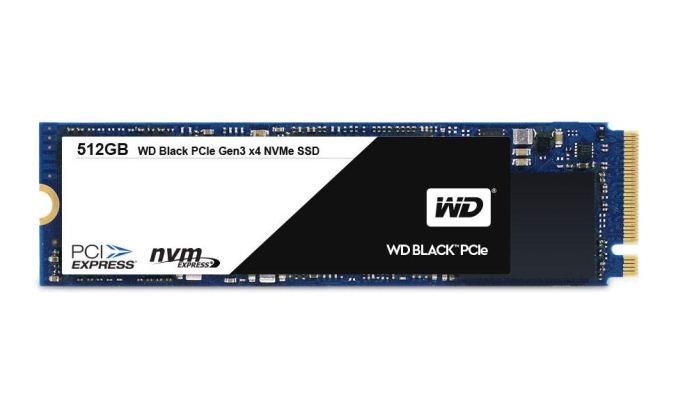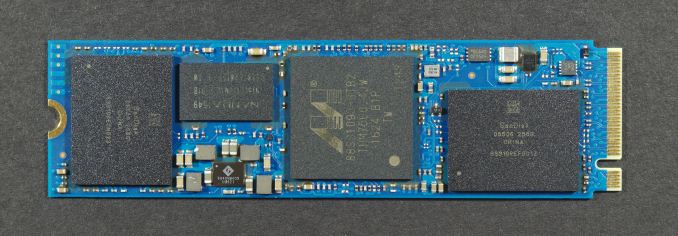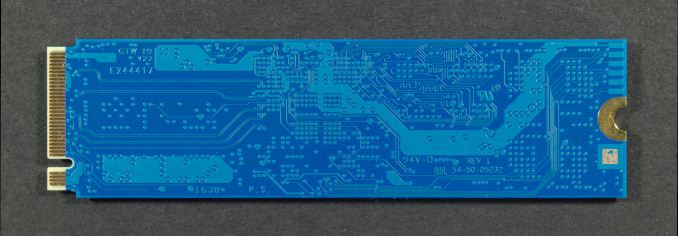The Western Digital Black PCIe SSD (512GB) Review
by Billy Tallis on March 8, 2017 8:30 AM EST
After acquiring SanDisk and introducing WD Green and WD Blue SSDs, it is no surprise to see Western Digital introduce a WD Black SSD that is a M.2 PCIe drive. In keeping with SanDisk's recent trends for mainstream consumer SSDs, the WD Black uses a Marvell controller (the 88SS1093, also seen in the Plextor M8Pe) and uses SanDisk's 15nm TLC NAND flash. And yes, the blue PCB is another SanDisk hallmark, even though it clashes with Western Digital's branding for the drive.
Western Digital and SanDisk are relatively late in bringing a consumer NVMe SSD to market. They're clearly intending for the WD Black SSD to be a fairly mainstream product by using TLC NAND and pricing it below high-end SATA SSDs. In the SATA space SanDisk has made very effective use of their planar TLC and the SanDisk X400 and WD Blue are the best in their class. Having taken their time developing the WD Black, we expect another solid performer. However, time is running out for planar TLC the WD Black may turn out to be a short-lived product before being replaced by a successor with 3D NAND. All four major NAND manufacturers plan to ship 64+ layer 3D NAND this year with TLC parts up to 512Gb, and if things go according to plan for at least two or three of them we should see the NAND shortage start to fade and prices and capacities improve.
| WD Black PCIe SSD Series Specifications | |||
| Capacity | 256GB | 512GB | |
| Form Factor | M.2 2280 | ||
| Interface | PCIe 3.0 x4 NVMe | ||
| Controller | Marvell 88SS1093 | ||
| NAND | SanDisk 15nm TLC | ||
| Sequential Read | 2050 MB/s | ||
| Sequential Write | 700 MB/s | 800 MB/s | |
| Random Read (4 KB) IOPS | 170k | 170k | |
| Random Write (4 KB) IOPS | 130k | 134k | |
| Power | Peak | 8.25 W | |
| Idle | 5.5 mW | ||
| Endurance | 80 TBW | 160 TBW | |
| Encryption | none | ||
| Warranty | 5 years | ||
| MSRP | $109 | $199.99 | |
The WD Black comes in only the two capacities that should be most popular: 256GB and 512GB. A 128GB PCIe SSD risks squandering much of the advantage of the faster interface due to the low number of NAND dies being a bottleneck, and 1TB PCIe SSDs are still expensive enough to be substantially less popular. A 1TB version would also need to be a double-sided M.2 module, which would limit compatibility with some laptops. As expected for a TLC SSD, the rated read performance is much higher than the write performance, though Western Digital does still give the WD Black a very nice looking random write rating. The endurance ratings for the WD Black are a little lower than I'd like to see given that even a TLC-based PCIe SSD is something of a premium product, but the five year warranty is quite reasonable.
Western Digital is currently taking pre-orders for the WD Black at MSRP and projecting a ship date of March 14, while there are already some third-party Amazon sellers offering it above MSRP. The MSRPs are about 10% higher than the current prices for the Intel SSD 600p, the current cheapest and slowest PCIe SSD.
For this review we will be comparing the 512GB WD Black primarily against other PCIe SSDs of similar capacity, and against a handful of the better SATA SSDs currently on the market. Some specific competitors to keep an eye on:
- The Plextor M8Pe uses the same Marvell controller and Toshiba's 15nm MLC counterpart to the 15nm TLC used by the WD Black.
- The WD Blue uses the same NAND as the WD Black, but a Marvell SATA SSD controller instead of the PCIe NVMe controller.
- The Intel SSD 600p based on Intel 3D TLC NAND and Silicon Motion's SM2260 controller is currently the cheapest and slowest NVMe SSD.
- The Samsung 960 EVO is the TLC PCIe SSD that's positioned above the WD Black in the market, and is the more mainstream of Samsung's current NVMe offerings.
| AnandTech 2015 SSD Test System | |
| CPU | Intel Core i7-4770K running at 3.5GHz (Turbo & EIST enabled, C-states disabled) |
| Motherboard | ASUS Z97 Pro (BIOS 2702) |
| Chipset | Intel Z97 |
| Memory | Corsair Vengeance DDR3-1866 2x8GB (9-10-9-27 2T) |
| Graphics | Intel HD Graphics 4600 |
| Desktop Resolution | 1920 x 1200 |
| OS | Windows 8.1 x64 |
- Thanks to Intel for the Core i7-4770K CPU
- Thanks to ASUS for the Z97 Deluxe motherboard
- Thanks to Corsair for the Vengeance 16GB DDR3-1866 DRAM kit, RM750 power supply, Carbide 200R case, and Hydro H60 CPU cooler












36 Comments
View All Comments
jjj - Wednesday, March 8, 2017 - link
At least it beats the Intel lolSuch a pity that SSD makers are messing around with slow options.
As NAND prices rise, the controller becomes a smaller % of the costs so offering great perf per $ is easy, as long as you have the perf and they don't.
I do have a bit of an objection to the way you talk about the 960 EVO in your conclusions.
You haven't tested the 500GB version or at least it's not in the graphs or bench and it's hard to be accurate in estimating its perf due to the SLC cache. A review for it would be nice and maybe the very popular MyDigitalSSD.
Gothmoth - Wednesday, March 8, 2017 - link
slow options are not bad if they would give me 2 TB for 200$... :)but this is just crappy stuff.
jjj - Wednesday, March 8, 2017 - link
Slow options with PCIe x4 drives so these things that offer too little over SATA.They make sense for OEMs in laptop and SFF, lower mechanical volume but the opportunity to make a buck is bigger with faster drives right now.
ImSpartacus - Thursday, March 9, 2017 - link
Yeah, pcie drives busy doubt make sense for the budget market at the moment.It's just an unnecessary cost for a use case that doesn't need the extra benefit. 2.5" sata drives can get too cheap and are too versatile.
theuglyman0war - Sunday, March 12, 2017 - link
Whats everyone complaining about? It's a.... OOPs! Read the that 800MB/s as if that was 800GB size for $199..LOL! nevermind...
Samus - Thursday, March 9, 2017 - link
I'd as clueless as everyone else as to why non-3D TLC is even a thing, especially in a product not limited by SATA.Bruce427 - Monday, March 13, 2017 - link
** A review for it would be nice [on] the very popular MyDigitalSSD. **I agree. I have one of their 480GB BPX models ($187.32) in one of my PCs and I cannot tell much difference between it and the Samsung 512GB 950 Pro.
The MyDigitals are probably the best performing lower priced NVMe drives. They also have a 5 year warranty and huge endurance (TBW) ratings.
ATB - Sunday, April 1, 2018 - link
huge endurance? Looking at 256GB size (80TBW for the WD Black) in the same price range: Intel's 600P is at 144, Kingston's KC1000 is at 300 ant Plextor's M8Pe is at... 384!!! Which means that the life-span of the black is less than 1/4 of the M8Pe's :(Mathieu Bourgie - Wednesday, March 8, 2017 - link
Reading the introduction: 'In the SATA space SanDisk has made very effective use of their planar TLC and the SanDisk X400 and WD Blue are the best in their class. 'Sure, the Sandisk X400 is a leading TLC drive, but how is the WD Blue the best in its class (and what class is that?).
From your own review of the WD Blue SSD: 'Unfortunately, the WD Blue is slower than the X400 on most other tests' and it has a 3 years warranty instead of 5 years for the Sandisk X400.
highlnder69 - Wednesday, March 8, 2017 - link
Not sure who would want to Pre-Order such a horrible performing SSD.